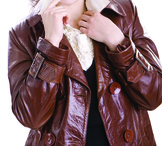FAQ'S - LEATHER
ESTIMATES & PRICING

Q. How much do you charge to clean a jacket?
A. The minimum amount for a plain leather jacket is $95.00 plus $24.95 return shipping and handling to you and includes $100.00 of insurance coverage.
A. The minimum amount for a plain leather jacket is $95.00 plus $24.95 return shipping and handling to you and includes $100.00 of insurance coverage.
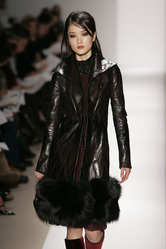
Q. What is considered a "designer" garment?
A. These are expensive garments generally valued at retail from $750 and up. They require special handling because of their decorations, coloration or because of the type of leather. If you have questions about your garment, we suggest you call or use our contact form on our website which allows you to upload 3 pictures..
A. These are expensive garments generally valued at retail from $750 and up. They require special handling because of their decorations, coloration or because of the type of leather. If you have questions about your garment, we suggest you call or use our contact form on our website which allows you to upload 3 pictures..
SHIPPING INFORMATION

Q. Do I have to ship my garment all the way to Kansas City?
A. Yes but you can get more specific info by submitting pictures and asking questions on our contact form . If you decline to have the work done after you receive our estimate, you are responsible for only the return shipping charges.
A. Yes but you can get more specific info by submitting pictures and asking questions on our contact form . If you decline to have the work done after you receive our estimate, you are responsible for only the return shipping charges.
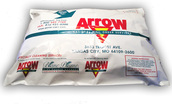
Q. How can I get the garment to you?
A. Go to the Arrow shipping options page. You will see two different options for shipping, and we pay the inbound shipping..
A. Go to the Arrow shipping options page. You will see two different options for shipping, and we pay the inbound shipping..

Q. What is the usual turnaround time?
A. Generally, you can plan for 2-3 weeks, including the shipping time. If you request an estimate, it will include the approximate turnaround time and the cost.
A. Generally, you can plan for 2-3 weeks, including the shipping time. If you request an estimate, it will include the approximate turnaround time and the cost.

Q. Why does the process take so long?
A. It depends on the condition of your garment and what you authorize us to do. To return your garment to peak condition may require many different processes. For example, heavy soil or staining, worn finish (elbow, wrist, collar), peeling finish or repairs (such as replacing a leather panel), are time consuming. If we do color restoration, the garment requires additional drying and finishing time. If we must repair or remove and replace the garment's lining, we require additional time.
A. It depends on the condition of your garment and what you authorize us to do. To return your garment to peak condition may require many different processes. For example, heavy soil or staining, worn finish (elbow, wrist, collar), peeling finish or repairs (such as replacing a leather panel), are time consuming. If we do color restoration, the garment requires additional drying and finishing time. If we must repair or remove and replace the garment's lining, we require additional time.
ALTERATIONS & REPAIRS

Q. Do you offer alterations?
A. Yes. We can do most anything needed if possible. Shorten, lengthen, take in, let out (by adding leather of course). Once we understand what needs to be done, we will provide an estimate by telephone or by mail.
A. Yes. We can do most anything needed if possible. Shorten, lengthen, take in, let out (by adding leather of course). Once we understand what needs to be done, we will provide an estimate by telephone or by mail.
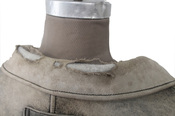
Q. What types of repairs will you do?
A. With your repair authorization, we will replace and color match leather panels, garment linings and closures such as buttons, hooks, snaps, zippers and Velcro®*. We will repair or replace torn pockets and worn collars and cuffs, replace knit trim, shorten sleeves and hems and much more.
A. With your repair authorization, we will replace and color match leather panels, garment linings and closures such as buttons, hooks, snaps, zippers and Velcro®*. We will repair or replace torn pockets and worn collars and cuffs, replace knit trim, shorten sleeves and hems and much more.
QUESTIONS FAQ'S
Using Home Products
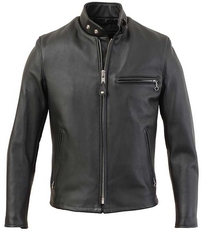
Q. We receive many, many leather care questions every year...but not often from Europe. We guess that our reputation for the most professional care of special leather and suede garments has spread far and wide.
Hello. I bought a Schott cafe racer jacket in steerhide (the 641), and I want to know what product I can use to take care, clean and preserve it in time. I wear it on motorcycle and in the street. I live in France and the cost to send it to U.S. will be expensive. We can have Lexol products, Vanson leather balm and the other in the list of web direction I put after. At Schott GAIL talk about mink oil but we can find it only in the shoes greases like Kiwi, Famaco for boots and outdoor shoes, or in the products for horse's leather saddles. May be it's good for motorcycle jackets? Thank you for the answer and sorry for my english.
A. You have purchased a finished horsehide jacket, finished means it has a finish on the leather that is basically a pliable paint especially formulated for that type of leather and for a specific use. My honest opinion is that you really need to do nothing, but wear it and enjoy it. For a period of time, you can wipe it off with a soft damp cloth, after it starts to get broken in, you may want to get a leather lotion similar to our Fine Leather Lotion, that has a very light wax in it that will provide a protective coating. I would stay away from silicone, or oily substances, that may serve to break down the leather finish.
Enjoy your new jacket!
Hello. I bought a Schott cafe racer jacket in steerhide (the 641), and I want to know what product I can use to take care, clean and preserve it in time. I wear it on motorcycle and in the street. I live in France and the cost to send it to U.S. will be expensive. We can have Lexol products, Vanson leather balm and the other in the list of web direction I put after. At Schott GAIL talk about mink oil but we can find it only in the shoes greases like Kiwi, Famaco for boots and outdoor shoes, or in the products for horse's leather saddles. May be it's good for motorcycle jackets? Thank you for the answer and sorry for my english.
A. You have purchased a finished horsehide jacket, finished means it has a finish on the leather that is basically a pliable paint especially formulated for that type of leather and for a specific use. My honest opinion is that you really need to do nothing, but wear it and enjoy it. For a period of time, you can wipe it off with a soft damp cloth, after it starts to get broken in, you may want to get a leather lotion similar to our Fine Leather Lotion, that has a very light wax in it that will provide a protective coating. I would stay away from silicone, or oily substances, that may serve to break down the leather finish.
Enjoy your new jacket!
Wrinkles & Leather
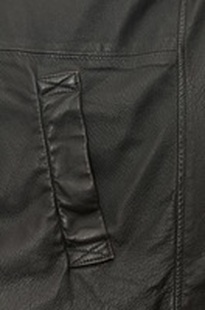
Q. How can I remove wrinkles from my leather jacket?
A. Unless the wrinkles are a design feature, you can use a low-temperature dry hand iron. Never use steam. Place brown paper between the iron and garment and constantly move the iron to avoid the overheating the leather. Too much heat will cause discoloration and damage to suedes and leathers.
A. Unless the wrinkles are a design feature, you can use a low-temperature dry hand iron. Never use steam. Place brown paper between the iron and garment and constantly move the iron to avoid the overheating the leather. Too much heat will cause discoloration and damage to suedes and leathers.
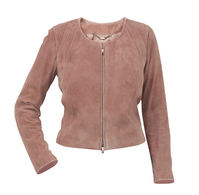
Q. Can I have my suede jacket drycleaned?
A. No. Suedes and leathers require special expertise for proper care and must be entrusted to a professional leather cleaner. The best way to keep your suede jacket looking like velvet is to brush it lightly - and regularly. Suedes and leathers need to be reconditioned periodically to ensure that suedes don't fade, and that surface cracks don't develop on finished leathers due to dryness.
A. No. Suedes and leathers require special expertise for proper care and must be entrusted to a professional leather cleaner. The best way to keep your suede jacket looking like velvet is to brush it lightly - and regularly. Suedes and leathers need to be reconditioned periodically to ensure that suedes don't fade, and that surface cracks don't develop on finished leathers due to dryness.
Leather Storage
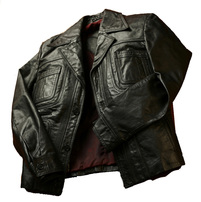
Q. How can I protect or /store my leather jacket during the off-season?
A. Leathers and suedes are subject to mildew so be certain the leather is completely dry before putting it away for the hot season. The best storage is in a breathable garment bag. This will protect your garment against dust and the leather will be able to breathe.
A. Leathers and suedes are subject to mildew so be certain the leather is completely dry before putting it away for the hot season. The best storage is in a breathable garment bag. This will protect your garment against dust and the leather will be able to breathe.
Shiny Patches
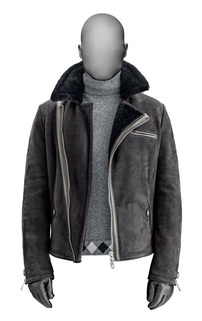
Q. My nubuck jacket has developed a shiny surface around the wrists and on the elbows. Is there anything I can do at home to take the shine off
A. Nubuck has a nap and it would seem that your jacket needs to have the nap raised. Without having seen the jacket, it's difficult to know if home care is the correct recommendation. Your jacket may need a good professional cleaning. However, Arrow has an inexpensive nubuck kit available that you can use to raise the nap on nubuck jackets - and shoes. Also, the kit allows you to gently clean lightly soiled nubuck. The good news is that you can use it for raising the nap on suede jackets, too.
A. Nubuck has a nap and it would seem that your jacket needs to have the nap raised. Without having seen the jacket, it's difficult to know if home care is the correct recommendation. Your jacket may need a good professional cleaning. However, Arrow has an inexpensive nubuck kit available that you can use to raise the nap on nubuck jackets - and shoes. Also, the kit allows you to gently clean lightly soiled nubuck. The good news is that you can use it for raising the nap on suede jackets, too.
Stains in Leather
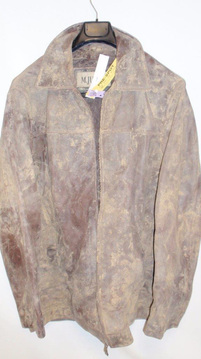
Q. My leather jacket is stained by (salad dressing, yellow mustard, blood, urine, ink, wine, wine sauce, grease, perspiration). Can it be saved?
A. Yes. In many cases, even a badly stained leather or suede garment can be saved, but each one can be different so it always helps us to know the origin of the stains. There are many variables when you factor in the cause of the stain with the different types of leather. Most manufacturers recommend that leather garments be cleaned by professional leather cleaning methods. This ensures that the stain will be treated properly, and that the suppleness, color and finish of the garment are maintained or restored. Arrow is an industry leader and trusted resource for the restoration and care of leather and suede garments, boots and handbags.
A. Yes. In many cases, even a badly stained leather or suede garment can be saved, but each one can be different so it always helps us to know the origin of the stains. There are many variables when you factor in the cause of the stain with the different types of leather. Most manufacturers recommend that leather garments be cleaned by professional leather cleaning methods. This ensures that the stain will be treated properly, and that the suppleness, color and finish of the garment are maintained or restored. Arrow is an industry leader and trusted resource for the restoration and care of leather and suede garments, boots and handbags.
Adhesive Badge Residue
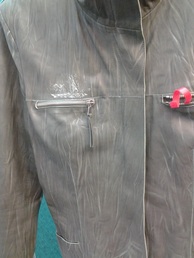
Q. I recently went to a party wearing my new leather coat, and before I knew it, I was wearing an adhesive-backed name badge. When I tried to remove it, that area of my coat lost its finish and I'm really upset. Can you help?
A. This is a problem that we see frequently. We can help you! Send the garment to us and we will remove the adhesive and lightly refinish the blemished area. Worst case, if the leather was severely damaged when the label was peeled off, we could replace the entire damaged panel. . You can request shipping materials be sent to you or you can download a pre-paid shipping label by following the instructions. or fill out the form. You can request an estimate and we will call or email you. We won't do anything until you have authorized the work. The usual turnaround time, including shipping, is 2 to 3 weeks
A. This is a problem that we see frequently. We can help you! Send the garment to us and we will remove the adhesive and lightly refinish the blemished area. Worst case, if the leather was severely damaged when the label was peeled off, we could replace the entire damaged panel. . You can request shipping materials be sent to you or you can download a pre-paid shipping label by following the instructions. or fill out the form. You can request an estimate and we will call or email you. We won't do anything until you have authorized the work. The usual turnaround time, including shipping, is 2 to 3 weeks
Paint on Leather
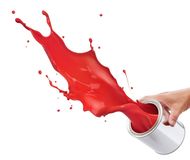
Q. Can you remove paint spilled on my leather jacket?
A. There are many variables in removing paint from a leather garment; for example, is it grain leather, nubuck or suede? Is the paint oil based, or water based? We have had quite a bit of experience with paint on leather and we have developed many different methods for paint removal. But our success on your particular garment will depend on what type and how much or how heavy the paint is and on what type of skin. When you send in your garment, please tell us what type of paint, if you know, and ask that we call you with an estimate of cost, and our opinion as to how successful we feel we will be with your garment before we do the work.
A. There are many variables in removing paint from a leather garment; for example, is it grain leather, nubuck or suede? Is the paint oil based, or water based? We have had quite a bit of experience with paint on leather and we have developed many different methods for paint removal. But our success on your particular garment will depend on what type and how much or how heavy the paint is and on what type of skin. When you send in your garment, please tell us what type of paint, if you know, and ask that we call you with an estimate of cost, and our opinion as to how successful we feel we will be with your garment before we do the work.
Mixed Leather and Fur/Mixed Textile and Fur
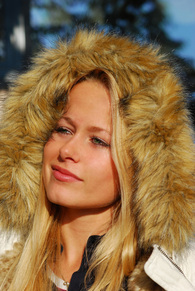
Q: I have a white rabbit and acrylic knit sweater jacket that I would like to send for cleaning, the care instructions say, "Do not wash. Do not dry-clean. Clean by specialist method only." Do you foresee any problems with cleaning it?
A. Your garment is a specialty item and we can clean it except, we could run into some limitations. The white rabbit and the white knit, cleaned together, means that one of the components (probably the white knit) will not be cleaned by the method that will offer the best possible results. The manufacturers cleaning instructions mean that the only safe method of cleaning this jacket would be the furrier cleaning method. That means the fur part of your jacket will be cleaned beautifully. The white acrylic knit portion, which would be best cleaned by washing, will not be cleaned very well because the furrier process does not provide for it. Dry-cleaning might be an option, but it is possible that either the rabbit or the knit would be ruined or changed to some degree because they really need different cleaning methods. Your jacket could be taken apart entirely and then reassembled, but in our opinion, the cost to you to do this, versus the cost of the jacket, could not be justified.
A. Your garment is a specialty item and we can clean it except, we could run into some limitations. The white rabbit and the white knit, cleaned together, means that one of the components (probably the white knit) will not be cleaned by the method that will offer the best possible results. The manufacturers cleaning instructions mean that the only safe method of cleaning this jacket would be the furrier cleaning method. That means the fur part of your jacket will be cleaned beautifully. The white acrylic knit portion, which would be best cleaned by washing, will not be cleaned very well because the furrier process does not provide for it. Dry-cleaning might be an option, but it is possible that either the rabbit or the knit would be ruined or changed to some degree because they really need different cleaning methods. Your jacket could be taken apart entirely and then reassembled, but in our opinion, the cost to you to do this, versus the cost of the jacket, could not be justified.
"Crocking" (Dye Problems)
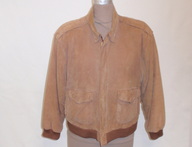
Q. I own a local leather shop, and a few of my new jackets have a "crocking problem" that I believe was caused in the manufacturing process. What can I use to stop this?
A. There is no satisfactory product available in the consumer marketplace to stop crocking. "Crocking" can be caused by one of two different processes. One is a shedding or linting that results after the leather is sueded. The other results from excess dyestuffs that can become a problem with either suede or grain leather. Each of these problems requires a different solution and process, and Arrow's technical staff must evaluate the garment to determine how to stop the crocking without altering the look or feel of the garments. Recently, when a large New York retailer refused a shipment from a major manufacturer because some of the garments were exhibiting a crocking problem, the manufacturer had them shipped to us at Arrow. We corrected the crocking, reshipped the garments and the retailer accepted the shipment for the Thanksgiving retail rush.
A. There is no satisfactory product available in the consumer marketplace to stop crocking. "Crocking" can be caused by one of two different processes. One is a shedding or linting that results after the leather is sueded. The other results from excess dyestuffs that can become a problem with either suede or grain leather. Each of these problems requires a different solution and process, and Arrow's technical staff must evaluate the garment to determine how to stop the crocking without altering the look or feel of the garments. Recently, when a large New York retailer refused a shipment from a major manufacturer because some of the garments were exhibiting a crocking problem, the manufacturer had them shipped to us at Arrow. We corrected the crocking, reshipped the garments and the retailer accepted the shipment for the Thanksgiving retail rush.
SHEARLING CARE

Q: What is shearling?
A: Shearling outerwear is made from tanned, sueded sheep or lamb skin with the fur (wool) worn on the inside and the suede on the outside. The warmth of a shearling garment is determined by the wool underfur, even if the longer outer hairs (also known as guard hairs) are shorn (cut off).
A: Shearling outerwear is made from tanned, sueded sheep or lamb skin with the fur (wool) worn on the inside and the suede on the outside. The warmth of a shearling garment is determined by the wool underfur, even if the longer outer hairs (also known as guard hairs) are shorn (cut off).

Q: Are shearling garments made by machine or by hand?
A: Shearling construction involves: hand selecting pelts, matching pelts for weight, color and suppleness, hand cutting, assembling the pieces and guiding the sewing machines by hand when seaming.
A: Shearling construction involves: hand selecting pelts, matching pelts for weight, color and suppleness, hand cutting, assembling the pieces and guiding the sewing machines by hand when seaming.
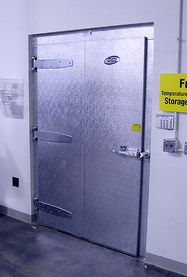
Q: How should I care for my shearling?
A: Have it cleaned, conditioned and glazed at least once a year, regardless of usage, just as you would a fine fur coat. The process restores natural oils and prevents drying and cracking. We recommend vault storage to prevent humidity damage during hot summer months.
A: Have it cleaned, conditioned and glazed at least once a year, regardless of usage, just as you would a fine fur coat. The process restores natural oils and prevents drying and cracking. We recommend vault storage to prevent humidity damage during hot summer months.

Q: Will rain, sleet or snow damage a shearling coat or jacket?
A: Accumulated moisture or light wetness should be shaken from the garment surface. Then hang the garment to dry away from direct heat but in a well-ventilated area. If you're caught in a torrential downpour or heavy snowfall, let dry naturally away from heat and then consider having the garment reconditioned by a professional leather cleaner such as Arrow.
A: Accumulated moisture or light wetness should be shaken from the garment surface. Then hang the garment to dry away from direct heat but in a well-ventilated area. If you're caught in a torrential downpour or heavy snowfall, let dry naturally away from heat and then consider having the garment reconditioned by a professional leather cleaner such as Arrow.
* Velcro® is a registered trademark of Velcro Industries B.V.

